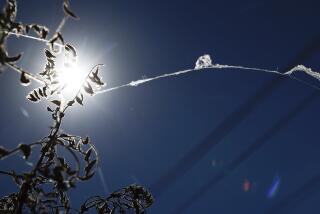Cellar Spiders
- Share via
ON FIRST GLANCE, they look like daddy-longlegs, tiny bodies with long, thread-thin legs. But they are true spiders--long-bodied cellar spiders with the processional name of Pholcus phalangioides-- and they are a common sight in the indoor hallways and outdoor toolsheds of Southern California.
Cellar spiders prefer dark places where they festoon their loose, sloppy webbings over ceilings and walls. Males and females build their webs next to each other, the strands often overlapping so it’s hard to tell which is his and which is hers. The result is lots of little spiders.
The further result is lots of spiders looking for homes, which they do at night. And that is why in the morning, there are new spider projects in the corner of the ceiling, or behind the speakers, or between the refrigerator and the stove. During the night, they have managed to crawl under the screens or through the cracks around the door; a full-grown Pholcus , which might occupy a 2-inch sphere of space with its legs, can squinch down to the size of a ladybug when exploring passages to a promised land.
But the most interesting trait of the cellar spider is the way it defends itself. Usually these gangly creatures suspend themselves absolutely motionless in the air, hanging upside down from their threads, their legs so slender they seem to merge with the silk itself. But let it sense the slightest hint of danger, and suddenly it begins to heave up and down. At the same time, it jerks back and forth, giving the illusion of violent spinning so that a predator, or anything else intending foul play, finds itself fac ing a mirage of motion. Somewhere among the dizziness is the little, vulnerable body of the cellar spider. To see how well this defense works, check out the toolshed--or try to sweep out the newest resident of the hall.






